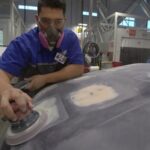Modern cars are equipped with sophisticated systems to keep you safe on the road, and traction control is a key player. You’ve probably heard about it, but what exactly does it do, and more importantly, what are some aspects that even seasoned car experts might not always highlight? Let’s delve into the world of traction control to uncover some lesser-known facts.
How Traction Control Really Works: Beyond the Basics
At its core, traction control is an electronic system designed to prevent wheel spin when you accelerate, especially on slippery surfaces. It uses sensors at each wheel, much like your Anti-lock Braking System (ABS), to constantly monitor wheel speed. When these sensors detect that one or more wheels are spinning significantly faster than the others – indicating a loss of traction – the traction control system springs into action.
But here’s a detail often understated: it’s not just about braking. While traction control does apply braking force to the spinning wheel, it can also reduce engine power momentarily. This dual approach – braking and engine power modulation – is crucial for regaining grip and maintaining vehicle stability. The system intelligently decides which method, or combination of methods, is most effective in a given situation, all happening in milliseconds. This nuanced interplay is something often simplified in basic explanations.
Traction Control vs. ABS: Understanding the Difference in Action
It’s common knowledge that traction control and ABS are related, often working with shared components. However, their roles are distinctly different and activated in contrasting scenarios. ABS is your braking ally, kicking in when you’re aggressively trying to stop to prevent wheel lock-up and maintain steering control during hard braking.
Traction control, on the other hand, is your acceleration assistant. Imagine you’re starting from a standstill on an icy patch. Your wheels might start to spin uncontrollably. This is where traction control steps in, reducing that spin so your tires can find grip and you can move forward smoothly. While both systems enhance safety, one is for stopping, and the other is for starting and maintaining control during acceleration. This crucial distinction in their operational context is vital for drivers to understand.
Beyond the Warning Light: What Traction Control Issues Really Mean
The appearance of the traction control warning light on your dashboard can be unsettling. While it certainly can signal a malfunction within the traction control system itself, such as a faulty module or sensor, the reasons can be more varied and sometimes less obvious.
The warning light can also illuminate due to issues within the ABS, since the two systems are intertwined. A problem with a wheel speed sensor, for example, could affect both ABS and traction control, triggering the warning light. Furthermore, seemingly unrelated issues, like certain engine or transmission problems that impact wheel speed readings, might also indirectly cause the traction control light to come on. Therefore, while the light is a clear indicator of a problem needing attention, a proper diagnosis is essential to pinpoint the root cause, which might not always be directly within the traction control system itself.
Conclusion: Traction Control as a Vital, Yet Complex System
Traction control is more than just a safety feature; it’s a complex system working behind the scenes to keep you in control in challenging driving conditions. Understanding its nuanced operation, its relationship with ABS, and the various reasons behind warning lights can empower you to be a more informed driver and car owner. Knowing these often-overlooked aspects of traction control ensures you appreciate its sophistication and the importance of maintaining its functionality for optimal vehicle safety and performance.

